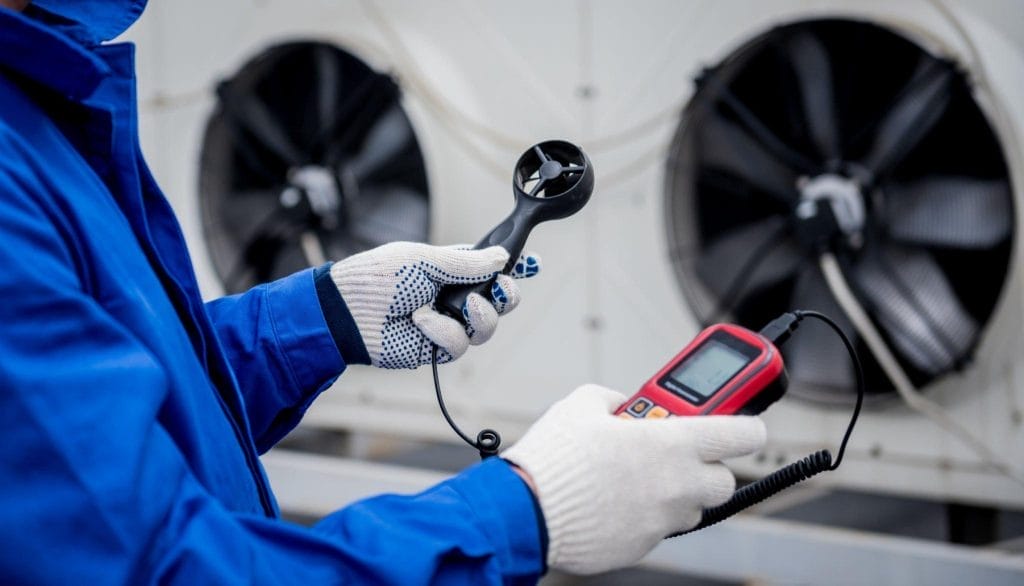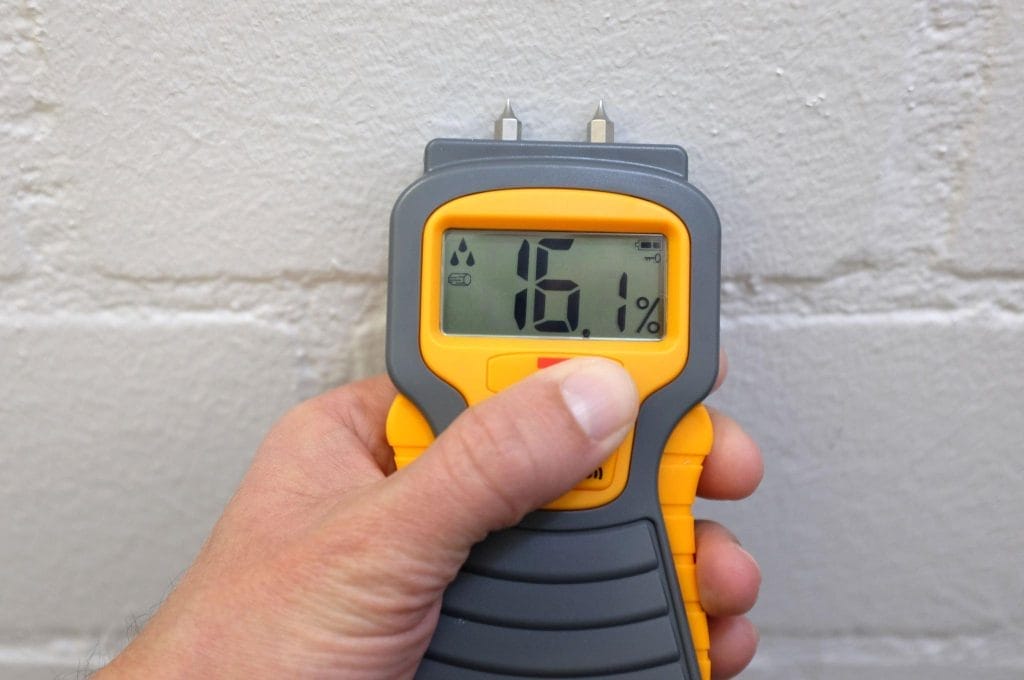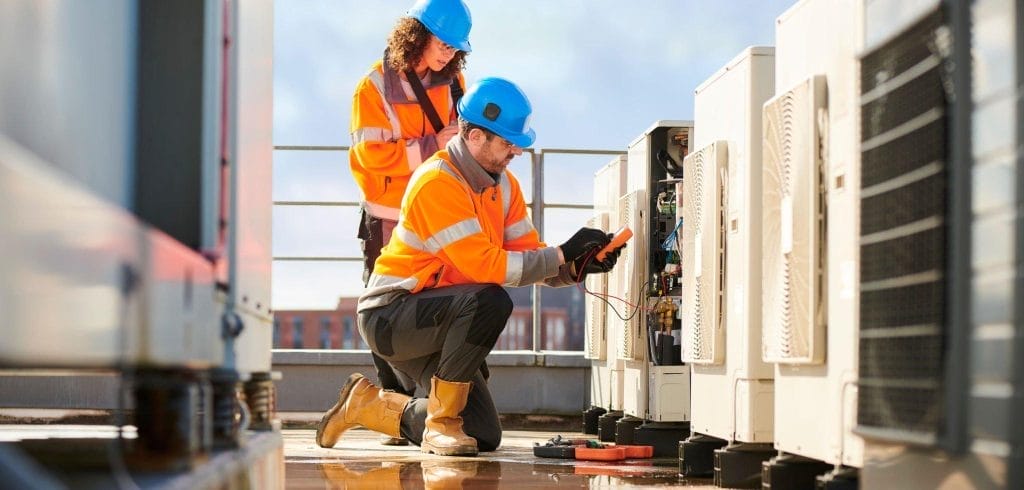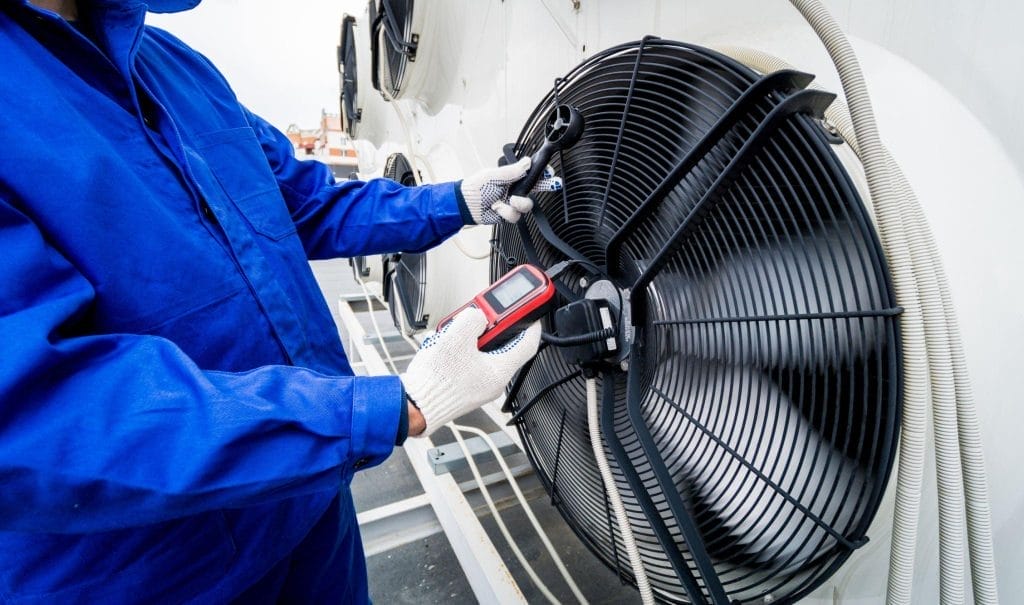Optimize Indoor Comfort and Efficiency with Our Expert Ventilation Audit Services!

With a dedicated team of certified ventilation auditors, we specialize in enhancing indoor air quality, comfort, and energy efficiency. At Elion Technologies, we understand the pivotal role that proper ventilation plays in maintaining a healthy and productive atmosphere. Our years of experience have honed our expertise, allowing us to offer comprehensive ventilation audit services that meet the highest industry standards. Our certified auditors bring a wealth of knowledge to every project, meticulously assessing your ventilation systems to identify potential inefficiencies, air quality concerns, and opportunities for improvement. Whether you’re a commercial entity seeking a conducive workspace or a residential homeowner aiming for a healthier living environment, Elion Technologies has you covered. Partner with us to experience firsthand the benefits of a well ventilated space. Breathe easier, save on energy costs, and enjoy the peace of mind that comes with knowing your indoor environment is in expert hands. Trust Elion Technologies – where innovation, experience, and air quality converge .
Breathe Fresh Air Today
Key Benefits
1. Expertise You Can Rely On: With over a decade of industry experience, Elion Technologies boasts a team of certified ventilation auditors who bring unparalleled expertise to every assessment.
2. Optimized Indoor Air Quality: Breathe easy knowing that our thorough ventilation audit will identify and address potential contaminants, allergens, and pollutants, ensuring the health and well-being of occupants.
3. Enhanced Energy Efficiency: Our auditors meticulously analyze ventilation systems to uncover inefficiencies, allowing you to significantly reduce energy consumption and lower operational costs.
4. Tailored Solutions: We understand that every space is unique. Our audits are customized to your specific needs, guaranteeing solutions that align with your goals and requirements.

5. Compliance and Regulations: Stay ahead of industry standards and regulations with our comprehensive audits, ensuring your ventilation systems meet the latest guidelines.
6. Improved Comfort: Experience a more comfortable indoor environment as we optimize air distribution, temperature control, and humidity levels, creating spaces where occupants thrive.
7. Long-Term Savings: By identifying and rectifying ventilation issues early on, our services can lead to substantial long-term savings through reduced maintenance costs and increased system lifespan.
Elevate your indoor environment with Elion Technologies – where innovation and expertise converge to create a breath of fresh air.
Invest in Indoor Well-Being
Key Features

At Elion Technologies, we take pride in offering top-tier ventilation audit services that set the standard for indoor air quality, comfort, and efficiency. With a decade of unwavering commitment to excellence, our certified auditors bring their expertise to every project, ensuring your space becomes a beacon of optimal ventilation.
Our Services:
1. Thorough Assessment: Our certified ventilation auditors conduct meticulous assessments of your ventilation systems, identifying potential issues, inefficiencies, and areas for improvement.
2. Indoor Air Quality Analysis: Breathe easier knowing that we evaluate your indoor air quality, identifying pollutants, contaminants, and allergens that may be compromising the health of occupants.
3. Energy Efficiency Evaluation: We delve into the energy performance of your ventilation systems, pinpointing opportunities to reduce consumption, save costs, and contribute to a greener environment.
4. Customized Solutions: Every space is unique, and our solutions reflect that. We tailor our recommendations to your specific needs, ensuring a customized approach that aligns with your goals.
5. Regulatory Compliance: Stay ahead of industry regulations and standards with our thorough audits, ensuring your ventilation systems adhere to the latest requirements.
6. Comfort Enhancement: Experience the luxury of optimal air distribution, temperature control, and humidity levels, transforming your space into a haven of comfort.
7. Actionable Recommendations: Our auditors don’t stop at identification; we provide you with clear, actionable recommendations to address any concerns and optimize your ventilation systems.
8. Long-Term Benefits: By resolving ventilation issues early on, our services can lead to long-term savings through reduced maintenance costs and extended system lifespans.
9. Expert Guidance: Benefit from the knowledge and insights of our certified auditors, who guide you through the audit process, answer your questions, and provide a clear roadmap to a healthier environment.
10. Proven Results: Join the ranks of our satisfied clients who have experienced the transformative effects of our ventilation audit services, and let us help you create an indoor space that’s second to none.
Claim Your Free Audit Consultation
Why choose us?
When it comes to ensuring optimal indoor air quality, energy efficiency, and overall comfort, Elion Technologies stands out as the premier choice. With a decade of industry leadership and a team of certified auditors, we offer a range of compelling reasons to choose us for your ventilation audit requirements:
1. Unmatched Expertise: With a track record dating back to 2010, Elion Technologies brings a wealth of experience to every ventilation audit. Our certified auditors possess in- depth knowledge of industry best practices and the latest advancements.
2. Certified Professionals: Our auditors hold industry-recognized certifications, showcasing their dedication to upholding the highest standards of quality and professionalism in every audit.

3. Custom-Tailored Approach: We understand that no two spaces are alike. Our ventilation audit solutions are personalized to your unique needs, ensuring that you receive recommendations that are effective and aligned with your goals.
4. Comprehensive Insights: Beyond identifying issues, we provide actionable recommendations and insights. Our auditors guide you through the findings, helping you understand the steps needed to achieve a healthier, more efficient indoor environment.
5. Commitment to Indoor Health: Your well-being is our priority. We meticulously analyze indoor air quality, pinpointing potential contaminants and allergens, to create spaces that promote health and comfort.
6. Energy Efficiency Focus: Elion Technologies is dedicated to helping you reduce energy consumption and cut costs. Our audits uncover inefficiencies in ventilation systems, providing opportunities for substantial energy savings.
7. Regulatory Compliance: Stay compliant with industry regulations effortlessly. Our audits ensure your ventilation systems adhere to the latest standards, minimizing any risks associated with non-compliance.
8. Proven Results: Our long list of satisfied clients attests to the transformative impact of our ventilation audit services. Join countless others who have experienced the positive change that Elion Technologies brings to indoor environments.
9. Holistic Approach: We don’t just address ventilation concerns; we enhance overall indoor comfort. From air distribution to humidity control, our audits create spaces where occupants thrive.
10. Future-Ready Solutions: Elion Technologies remains at the forefront of industry advancements. By choosing us, you access cutting-edge solutions that position your indoor environment for a sustainable and innovative future.
Start Your Audit Journey
Industry Experience

Elion Technologies and Consulting Private Limited has been a prominent player in the field since 2010, accumulating a decade of invaluable industry experience. Our journey through the years has been marked by continuous learning, innovation, and a steadfast commitment to excellence.
Our Milestones:
1. Established Presence: Since our inception, we have been at the forefront of promoting healthier indoor environments through efficient ventilation systems. Our early years were characterized by laying the foundation for a company dedicated to quality and customer
satisfaction.
2. Industry Evolution: Over the years, we’ve witnessed the evolution of ventilation technology and practices. Adapting to changes and embracing advancements, we have consistently fine-tuned our approach to ensure we deliver the most relevant and effective solutions.
3. Certified Auditors: Our team comprises certified ventilation auditors with extensive training and hands-on experience. This expertise enables us to provide cutting-edge services that meet the highest industry standards.
4. Client Success Stories: Our journey is intricately linked with the success stories of our diverse clientele. From commercial spaces to residential properties, we have played a pivotal role in enhancing indoor air quality and energy efficiency for a wide range of applications.
5. Innovation and Adaptation: As industry landscapes shift, we have remained proactive in adopting new methodologies and technologies. This has empowered us to consistently exceed client expectations and deliver solutions that are future-ready.
6. Trusted Relationships: Our years in the industry have allowed us to build strong relationships with clients, partners, and regulatory bodies. These connections reflect our commitment to professionalism, integrity, and long-term collaboration.
7. Vision for Tomorrow: Looking ahead, we remain dedicated to pushing boundaries and setting new standards in ventilation audit services. Our decade-long experience serves as a solid foundation upon which we continue to build a brighter, healthier future for indoor environments.
At Elion Technologies, our decade of industry experience is not just a timeline—it’s a testament to our unwavering dedication, growth, and expertise. Join us as we journey forward, driven by a passion for creating indoor spaces that truly make a difference.
Unlock a Comfort Revolution
FAQs
A ventilation audit is a thorough assessment of your indoor space’s ventilation systems to evaluate their effectiveness, energy efficiency, and air quality impact.
A ventilation audit ensures your indoor air quality is healthy, helps identify energy-saving opportunities, and ensures compliance with industry standards.
For commercial spaces, annual audits are recommended. Residential properties can benefit from audits every 2-3 years, or more often if there are concerns.
Benefits include improved air quality, energy savings, extended system lifespan, compliance, and enhanced occupant comfort.
The duration varies based on the size and complexity of the space. It can take a few hours to a full day.
Efforts are made to minimize disruption. Our auditors work efficiently to complete the assessment with minimal impact.
Our auditors are certified professionals with extensive training and experience in ventilation systems.
Absolutely. A ventilation audit identifies inefficiencies, helping optimize your systems for energy savings.
Yes, our auditors will provide a detailed report with findings, recommendations, and potential improvements.
Yes, we offer ventilation audit services for both residential and commercial properties.
You can schedule an audit by contacting us via phone, email, or our website’s scheduling form.
Yes, the energy savings and potential system longevity improvements often offset the cost of the audit.
We assess a wide range of ventilation systems, including HVAC, natural ventilation, exhaust systems, and more.
Yes, better air quality and comfort can positively impact employee well-being and productivity.
While we focus on the assessment, we can recommend maintenance schedules and partners for any necessary work.
Yes, our audits ensure your systems meet industry regulations and standards.
Absolutely, an audit during the construction phase ensures proper system installation and compliance.
Contact us for an audit. We’ll assess the situation and recommend necessary actions.
Results can vary, but improvements in air quality and comfort are often noticeable after addressing identified issues.
If you experience discomfort, notice poor air quality, have high energy bills, or haven’t had an audit in years, it’s a good time to consider one.
Inadequate ventilation can have a range of negative effects on indoor environments and the people within them. Ventilation refers to the process of exchanging indoor air with outdoor air to maintain air quality and regulate temperature and humidity. When ventilation is inadequate, several issues can arise:
Poor Air Quality: Inadequate ventilation can lead to a buildup of indoor air pollutants such as dust, allergens, volatile organic compounds (VOCs), and carbon dioxide (CO2). These pollutants can negatively impact respiratory health, trigger allergies, and contribute to the “sick building syndrome,” where occupants experience symptoms like headaches, fatigue, and irritation.
Increased Humidity: Poor ventilation can lead to higher indoor humidity levels. Excess humidity can promote the growth of mold, mildew, and dust mites, which can exacerbate allergies and respiratory issues. It can also lead to structural damage and reduce overall comfort.
Temperature Regulation: Ventilation plays a role in regulating indoor temperature. Inadequate ventilation can lead to temperature imbalances, making some areas of a building too hot or too cold. This can affect occupant comfort and productivity.
Condensation: Without proper ventilation, condensation can occur on windows, walls, and other surfaces. Condensation can contribute to mold growth, deterioration of building materials, and potential health issues for occupants.
Stale Air and Odors: Inadequate ventilation can lead to a buildup of stale air and unpleasant odors. This can make indoor spaces uncomfortable and less inviting.
CO2 Buildup: A lack of ventilation can lead to elevated levels of carbon dioxide (CO2) indoors. High CO2 concentrations can cause drowsiness, headaches, and impaired cognitive function, which can impact productivity and overall well-being.
Health Issues: Long-term exposure to poor indoor air quality due to inadequate ventilation has been associated with respiratory diseases, allergies, and other health problems.
Energy Efficiency: Inadequate ventilation can also affect energy efficiency. Without proper ventilation, heating and cooling systems may need to work harder to maintain comfortable indoor conditions, leading to increased energy consumption and higher utility bills.
There are four main types of ventilation used to provide fresh air and regulate indoor air quality in buildings:
Natural Ventilation: This type of ventilation relies on the natural movement of air through openings such as windows, doors, and vents. It takes advantage of wind and temperature differences to facilitate air exchange. Natural ventilation can be simple and cost-effective but may be less controllable compared to mechanical systems.
Mechanical Ventilation: Mechanical ventilation involves the use of fans, blowers, and other mechanical devices to forcibly move air in and out of a building. There are several subtypes of mechanical ventilation, including:
Exhaust Ventilation: This type removes stale air and pollutants from indoor spaces, typically by using exhaust fans in areas like kitchens and bathrooms. It creates a negative pressure that draws fresh air in from outside through unintentional openings.
Supply Ventilation: In this approach, fresh outdoor air is mechanically brought into the building through supply fans, which can be filtered and conditioned before distribution. Supply ventilation helps maintain a positive pressure indoors.
Balanced Ventilation: Balanced ventilation combines both exhaust and supply systems to achieve a balanced airflow, helping to control air pressure and maintain a controlled exchange of fresh air.
Spot Ventilation: Spot ventilation is a localized approach that uses fans or exhaust systems to remove pollutants and moisture from specific areas, such as kitchens, bathrooms, and laundry rooms. While it doesn’t provide whole-building ventilation, it can be effective in areas with higher concentrations of pollutants.
Hybrid Ventilation: Hybrid ventilation combines elements of both natural and mechanical ventilation to optimize indoor air quality and energy efficiency. It aims to take advantage of natural airflow when conditions allow and switches to mechanical systems when necessary to maintain comfort and air quality.
In the context of mechanical ventilation systems used in buildings, there are two primary modes of ventilation:
Supply Ventilation: In supply ventilation, fresh outdoor air is brought into the building through mechanical means, such as fans or blowers. The outdoor air is filtered and often conditioned (heated or cooled) before being distributed to different indoor spaces. Supply ventilation helps maintain positive indoor air pressure and ensures a controlled introduction of fresh air. This mode of ventilation is particularly useful in situations where outdoor air quality is better than indoor air quality or when there’s a need to provide controlled ventilation rates.
Exhaust Ventilation: In exhaust ventilation, indoor air is mechanically removed from the building using exhaust fans or blowers. Stale air, pollutants, and moisture are extracted from various indoor spaces, such as kitchens, bathrooms, and utility rooms. This creates a negative pressure indoors, which can draw in outdoor air through unintended openings (like gaps around windows and doors) to replace the air being exhausted. Exhaust ventilation is commonly used to remove specific sources of pollutants and control humidity levels.
Both supply and exhaust ventilation modes can be used individually or in combination, depending on the specific requirements and design considerations of the building. In some cases, a balanced ventilation approach is taken, which involves providing a relatively equal amount of fresh outdoor air through supply and exhaust systems to achieve a controlled exchange of indoor and outdoor air. Hybrid ventilation, as mentioned earlier, is a strategy that combines elements of both natural and mechanical ventilation modes to optimize indoor air quality and energy efficiency.
Ventilator pressure refers to the air pressure applied by a mechanical ventilator to deliver and support the respiratory needs of a patient who is unable to breathe adequately on their own. Mechanical ventilators are medical devices used in critical care settings to assist patients with breathing when their respiratory muscles are weakened or compromised due to various medical conditions.
There are several types of ventilator pressures that are important in managing a patient’s respiratory support:
Positive Inspiratory Pressure (PIP): PIP is the maximum airway pressure generated during the inspiratory phase of mechanical ventilation. It represents the peak pressure applied to the patient’s airways to deliver a breath. PIP is often adjusted to achieve proper lung inflation and oxygenation.
Positive End-Expiratory Pressure (PEEP): PEEP is the pressure applied to the airways at the end of exhalation (expiration) to prevent the collapse of alveoli (tiny air sacs in the lungs) and improve oxygen exchange. PEEP helps maintain lung volume and can be adjusted to optimize oxygenation and lung compliance.
Peak Inspiratory Pressure (PIP): Similar to PIP, peak inspiratory pressure is the maximum pressure applied during inspiration. It includes the effects of the ventilator pressure as well as the resistance and compliance of the patient’s respiratory system.
Plateau Pressure: Plateau pressure is the airway pressure measured during a pause in the inspiratory phase of mechanical ventilation. It reflects the pressure within the alveoli when no airflow is occurring. Plateau pressure is used to assess lung compliance and can help prevent lung injury.
Mean Airway Pressure (MAP): MAP is the average pressure in the patient’s airways over a full respiratory cycle. It accounts for both inspiratory and expiratory phases and contributes to oxygenation and carbon dioxide removal.
Driving Pressure: Driving pressure is the difference between the plateau pressure and the positive end-expiratory pressure (PEEP). It is used to assess the pressure gradient across the lung during mechanical ventilation and can provide insights into lung protection strategies.
Proper ventilation promotes indoor air quality, reduces the spread of pollutants, and ensures occupant comfort.
Outbound Link: Benefits of Good Ventilation
Ventilation Audits should be conducted regularly, with frequency depending on building use and local regulations.
Outbound Link: Ventilation Audit Frequency Guidelines
Signs include stale air, humidity issues, odors, and mold growth.
Outbound Link: Identifying Poor Ventilation
Various local and international codes and standards apply, such as ASHRAE and OSHA.
Outbound Link: ASHRAE Ventilation Standards
Audits can assess ventilation systems’ effectiveness in reducing the transmission of airborne diseases.
Outbound Link: Ventilation and COVID-19
Yes, audits can uncover safety concerns like inadequate fire dampers or blocked vents. – Outbound Link: Safety in Ventilation Systems



